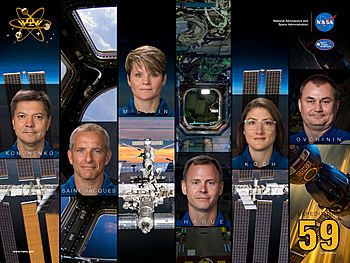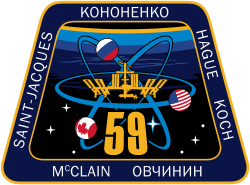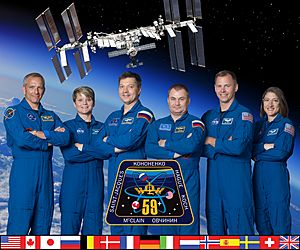Expedition 59 facts for kids

Promotional Poster
|
|
| Mission type | ISS Expedition |
|---|---|
| Mission duration | 101d 22h 24m |
| Expedition | |
| Space Station | International Space Station |
| Began | 15 March 2019 01:01 UTC |
| Ended | 24 June 2019 23:25 UTC |
| Arrived aboard | Soyuz MS-11 Soyuz MS-12 |
| Departed aboard | Soyuz MS-11 |
| Crew | |
| Crew size | 6 |
| Members |
|
| EVAs | 4 |
| EVA duration | 25h 55min |
 Expedition 59 mission patch  (l-r) Saint-Jacques, McClain, Kononenko, Ovchinin, Hague and Koch ISS expeditions
|
|
Expedition 59 was a special trip to the International Space Station (ISS). It was the 59th time a group of astronauts lived and worked there. This mission began on March 15, 2019.
The expedition started when the Soyuz MS-12 spacecraft arrived. It brought Aleksey Ovchinin, Nick Hague, and Christina Koch to the ISS. They joined Oleg Kononenko, David Saint-Jacques, and Anne McClain. These three astronauts had already been on the station as part of Expedition 58.
Aleksey Ovchinin and Nick Hague had a challenging journey before this. They were supposed to fly to the ISS earlier on Soyuz MS-10. However, their rocket had a problem right after launch. They had to return to Earth safely.
Expedition 59 officially ended on June 24, 2019. This was when the Soyuz MS-11 spacecraft left the station. Oleg Kononenko, David Saint-Jacques, and Anne McClain returned to Earth on it. Aleksey Ovchinin, Nick Hague, and Christina Koch stayed on the ISS. They then became part of the next mission, Expedition 60.
Contents
Meet the Astronauts: Expedition 59 Crew
Six brave astronauts were part of Expedition 59. They worked together to keep the International Space Station running. They also performed many important science experiments.
| Position | Crew member | |
|---|---|---|
| Commander | This was his fourth trip to space! |
|
| Flight Engineer 1 | This was his first time in space. |
|
| Flight Engineer 2 | This was her first time in space. |
|
| Flight Engineer 3 | This was his third trip to space. |
|
| Flight Engineer 4 | This was his second trip to space. |
|
| Flight Engineer 5 | This was her first time in space. |
|
Spacewalks: Working Outside the ISS
During Expedition 59, astronauts went on four spacewalks. A spacewalk is when astronauts leave the ISS to work outside. They wear special suits to protect them in space. These spacewalks lasted a total of 25 hours and 55 minutes.
| Spacewalk Number | Astronauts | Start Time (UTC) | End Time (UTC) | How Long | |
| Expedition 59 EVA 1 |
March 22, 2019 12:01 PM |
March 22, 2019 6:40 PM |
6 hours, 39 minutes | ||
| Anne McClain and Nick Hague worked on the station's power system. They installed special plates to help swap batteries. They also cleaned up some parts of the Unity Module. This helped get the station ready for new supply ships. | |||||
| Expedition 59 EVA 2 |
March 29, 2019 11:42 AM |
March 29, 2019 6:27 PM |
6 hours, 45 minutes | ||
| Nick Hague and Christina Koch continued the battery work. They installed more plates on the P4 Truss. Christina Koch became the 14th woman to walk in space during this spacewalk. This spacewalk was originally planned for two women, but a problem with a spacesuit changed the plan. | |||||
| Expedition 59 EVA 3 |
April 8, 2019 11:31 AM |
April 8, 2019 6:00 PM |
6 hours 30 minutes | ||
| Anne McClain and David Saint-Jacques worked on the Canadarm2. This is a robotic arm used to move things outside the station. They also prepared the Columbus Module for new equipment. David Saint-Jacques was the first Canadian astronaut to do a spacewalk since Chris Hadfield. | |||||
| Expedition 59 EVA 4 |
May 29, 2019 3:42 PM |
May 29, 2019 9:43 PM |
6 hours 1 minute | ||
| Oleg Kononenko and Aleksey Ovchinin worked on the Russian parts of the station. They removed old experiments and cleaned windows. They also moved some equipment and installed a new handrail. They even sang "Happy Birthday" to a famous Russian cosmonaut, Alexei Leonov, who was the first person to ever walk in space! | |||||
Supply Missions to the ISS
Several uncrewed spacecraft visited the International Space Station during Expedition 59. These ships brought fresh supplies, equipment, and new experiments to the astronauts. They also took away trash and old equipment.
| Spacecraft - ISS flight number |
Country | What it Carried | Rocket Used | Launch (UTC) |
Docked/Berthed (UTC) |
Undocked/Unberthed (UTC) |
Time at Station | How it Ended |
|---|---|---|---|---|---|---|---|---|
| Progress MS-11 - ISS 72P |
Supplies | Soyuz-2.1a | April 4, 2019, 11:01 AM | April 4, 2019, 2:22 PM | July 29, 2019, 10:44 AM | 115d 20h 22m | Burned up in Earth's atmosphere on July 29, 2019, 1:50 PM | |
| Cygnus NG-11 - CRS NG-11 |
Supplies | Antares 230 | April 17, 2019, 8:46 PM | April 19, 2019, 9:28 AM | August 6, 2019, 4:15 PM | 109d 6h 47m | Burned up in Earth's atmosphere on December 6, 2019, 3:28 PM | |
| SpaceX CRS-17 - SpX-17 |
Supplies | Falcon 9 | May 4, 2019, 6:48 AM | May 6, 2019, 1:33 PM | June 3, 2019, 4:01 PM | 28d 2h 28m | Burned up in Earth's atmosphere on June 3, 2019, 8:56 PM |
Science and Experiments on Expedition 59
The astronauts on Expedition 59 did many important science experiments. They used the unique environment of microgravity (weightlessness) in space.
- Tissue Chips: Researchers studied "tissue chips." These are tiny models of human organs. In space, these chips can show how aging and diseases affect the body faster. This helps scientists learn more about human health.
- Space Soil: They also did experiments with "regolith simulants." This is like fake soil from other planets or moons. This helps prepare for future missions to the Moon or Mars.
- Earth's Carbon Cycle: Astronauts studied Earth's atmospheric carbon cycle. This helps us understand how carbon moves through our planet's air, land, and oceans. It's important for understanding climate change.
- Astrobee Robots: They tested Astrobee robots. These are small, free-flying robots designed to help with daily chores on the ISS. They can also help with experiments, freeing up astronauts' time.
See also
 In Spanish: Expedición 59 para niños
In Spanish: Expedición 59 para niños

